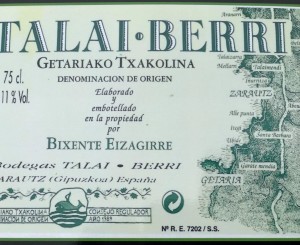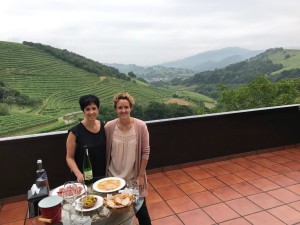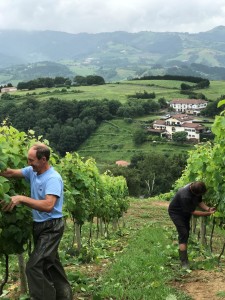Today we have a conference preview from Carl Etcheverry, CSW. Carl tells us about his travels through the Basque Country in Spain, and along the way, introduces use to some of the wines that will be poured at his upcoming conference session, “A Basque Adventure.”
There is a grape that grows along the dramatic Atlantic Coastline of Bay of Biscay in the province of Gipuzkoa. This green grape—known as Hondarribi Zuri—is grown by a group of small local family farms, and is used in the production of Txakoli.
Txakoli is typically a white wine (although red and rosado versions exist), and it has been produced in Spain’s Basque Country since as far back as Medieval Times. Centuries later, in the 16th century, Basque sailors took barrels of Txakoli with them while hunting whales or fishing for cod in the cold waters of Newfoundland in order to prevent scurvy on their long journeys.
The Denominación de Origen for Getariako Txakolina created in 1989 was extended in 2008 from the three original villages (Getaria, Zarrautz and Aia) to include the whole of the region of the Gipuzkoa Province. Today the Getariako Txakolina DO spreads over 430 hectares (only half them planted with vines). The annual wine production represents 4 million bottles.
During my trip to the region, I was lucky enough to visit the Talai Berri winery. Founded in 1992 by Bixente Eizagirre Aginaga, Talai Berri is one of the 30 bodegas in the Gipuzkoa Province and one of 11 located in the village Zarautz. The family estate is 30 acres (12 hectares), and is the only Bodega in the area to have onsite a weather station (a very helpful tool to manage to tend the vineyards). The estate practices sustainable farming methods, and fermentation and ageing of the wine is done in stainless steel vats (no oak). The camino that guides pilgrims to Santiago de Compostella passes through the vineyard.
In 2000, Talai Berri was the first winery to produce a red version of Txakoli, using the red Hondarribi Beltza variety. The Hondarribi Zuri (white) and Hondarribi Beltza (red varietal) represents each 50 % of the vines planted. The Bodega Talai Berri produces around 90,000 bottles of white, 6,000 bottles of rosado, and 3,000 bottles of red wine per year.
The early morning drive from Saint Etienne-De-Baigorry to the Talai Berri winery in Zarautz took me through thick fog while crossing the dangerous Col d’Ispeguy (1000 meters mountain pass) where I encountered wild horses appearing like ghosts in front of the car. In this region, where 1,870 millimeters (73 inches) of annual rainfall is the norm, the flowering apple trees compete with the vines for the scarce rays of sunshine. After this 3-hour drive, I finally arrived one minute in advance of my appointment scheduled at 9:30 am! That morning, I skipped breakfast to leave early and neglected to drink water.
When I arrived at the entrance door, I looked pale and green olive. My hostesses welcomed me at the winery with a bottle of Txakoli and kindly brought plates filled with specialties from the fishing village of Getaria: anchovies, fresh tuna and marinated peppers.
I toured the vineyards guided by Itzear, one of the two daughters running the family estate. I noticed that the vines were pruned and trained with the double Guyot System, avoiding the more productive Pergola System commonly used for the production of Albariño in the region of Rías Baixas.
Walking through the rows of vines, I noticed some mildew (a white powdery fungus) covering some of the leaves. Vineyard workers were removing leaves, making sure that there is a good aeration between the feet of the vines to prevent the development of rot caused by the high humidity level.
Back at the tasting room, I enjoyed a glass of white Txakoli: The wine had a luminous pale gold robe, a moderate still nose, with aromas of lemon and green apples on the palate. The wine was precise, ultra-crisp, with a long, mouthwatering finish. I also tasted their Txakoli Rosado (3 hours of skin contact), a Rose “de Coupage” with an orange hue, bracing acidity and gentle aromas of clementine. The Txakoli made with the Hondarribi Beltza (red) variety had a rather pale red robe and strawberry flavor.
My “Basque Adventure” journey to discover the wines of my ancestors started rather well. This quest of identity through wine brought me to the heart of the Basque culture—from the Annual Solstice Celebrations in the coastal town of San Sebastián, to the Bodegas Ochoa in the Navarra Kingdom and then through the deep inland desert landscapes of Rioja Alavesa (Bodegas Remelluri), finally ending in the rolling hills and green pastures of Irouléguy on the French side (Domaine Brana and Domaine Arretxea).
Carl’s session, “A Basque Adventure,” will be presented on Thursday, August 10, 2017 at 10:30 am as part of the 41st Annual Conference of the Society of Wine Educators, to be held in Portland, Oregon.



